Post by Infinity Blade on Jun 2, 2016 7:40:40 GMT 5
Goronyosaurus nigeriensis

A life reconstruction of G. nigeriensis. © @ DeviantArt user DiBgd
Temporal range: Late Cretaceous (Maastrichtian)
Scientific classification:
Life
Domain: Eukaryota
(unranked): Unikonta
(unranked): Opisthokonta
(unranked): Holozoa
(unranked): Filozoa
Kingdom: Animalia
Subkingdom: Eumetazoa
(unranked): Bilateria
Clade: Nephrozoa
Superphylum: Deuterostomia
Phylum: Chordata
Subphylum: Olfactores
Clade: Craniata
Subphylum: Vertebrata
Infraphylum: Gnathostomata
Clade: Eugnathostomata
Clade: Teleostomi
Superclass: Tetrapoda
Clade: Reptiliomorpha
Clade: Amniota
Class: Reptilia or Clade: Sauropsida
Clade: Eureptilia
Clade: Romeriida
Clade: Diapsida
Clade: Neodiapsida
Clade: Sauria
Infraclass: Lepidosauromorpha
Superorder: Lepidosauria
Order: Squamata
Clade: Toxicofera
Infraorder: Anguimorpha
Clade: Pythonomorpha
Superfamily: †Mosasauroidea
Family: †Mosasauridae
Genus: †Goronyosaurus
Species: †G. nigeriensis
 Skull of Goronyosaurus.
Skull of Goronyosaurus.
Goronyosaurus ("Goronyo lizard/reptile") is a genus of mosasaur that lived in what is now Nigeria and Niger during the Maastrichtian stage of the Late Cretaceous.
Description & habits:
Goronyosaurus had a crocodile-like skull. The teeth fit into interdental pits on the opposite jaw bone; in other words, Goronyosaurus had interlocking teeth, which evidently would have aided in retaining a grip on prey. In the premaxilla and the anterior end of the dentary, the teeth were slightly longer than the longest teeth elsewhere in the toothrow. These long and reinforced teeth would have allowed Goronyosaurus to quickly apprehend comparatively-hard-to-catch, slippery prey.[1]
The orbits of Goronyosaurus were comparatively small for a mosasaur and the skull had an unusually high number of foramina. It was suggested that Goronyosaurus had reduced eyesight and enhanced tactile abilities to find prey in sediment and by extension, murky, hard-to-see areas. These ideas have yet to undergo comprehensive scrutiny and regardless of the animal's true sensory abilities, Goronyosaurus would almost certainly have had a forked tongue (like other mosasaurs), giving it excellent vomeronasal chemoreception.[1]

Cranial reconstruction of Goronyosaurus. © @ Ocean of Kansas
References:
[1] Tongues, venom glands, and the changing face of Goronyosaurus (2009 Tetrapod Zoology article by Darren Naish).

A life reconstruction of G. nigeriensis. © @ DeviantArt user DiBgd
Temporal range: Late Cretaceous (Maastrichtian)
Scientific classification:
Life
Domain: Eukaryota
(unranked): Unikonta
(unranked): Opisthokonta
(unranked): Holozoa
(unranked): Filozoa
Kingdom: Animalia
Subkingdom: Eumetazoa
(unranked): Bilateria
Clade: Nephrozoa
Superphylum: Deuterostomia
Phylum: Chordata
Subphylum: Olfactores
Clade: Craniata
Subphylum: Vertebrata
Infraphylum: Gnathostomata
Clade: Eugnathostomata
Clade: Teleostomi
Superclass: Tetrapoda
Clade: Reptiliomorpha
Clade: Amniota
Class: Reptilia or Clade: Sauropsida
Clade: Eureptilia
Clade: Romeriida
Clade: Diapsida
Clade: Neodiapsida
Clade: Sauria
Infraclass: Lepidosauromorpha
Superorder: Lepidosauria
Order: Squamata
Clade: Toxicofera
Infraorder: Anguimorpha
Clade: Pythonomorpha
Superfamily: †Mosasauroidea
Family: †Mosasauridae
Genus: †Goronyosaurus
Species: †G. nigeriensis
Goronyosaurus ("Goronyo lizard/reptile") is a genus of mosasaur that lived in what is now Nigeria and Niger during the Maastrichtian stage of the Late Cretaceous.
Description & habits:
Goronyosaurus had a crocodile-like skull. The teeth fit into interdental pits on the opposite jaw bone; in other words, Goronyosaurus had interlocking teeth, which evidently would have aided in retaining a grip on prey. In the premaxilla and the anterior end of the dentary, the teeth were slightly longer than the longest teeth elsewhere in the toothrow. These long and reinforced teeth would have allowed Goronyosaurus to quickly apprehend comparatively-hard-to-catch, slippery prey.[1]
The orbits of Goronyosaurus were comparatively small for a mosasaur and the skull had an unusually high number of foramina. It was suggested that Goronyosaurus had reduced eyesight and enhanced tactile abilities to find prey in sediment and by extension, murky, hard-to-see areas. These ideas have yet to undergo comprehensive scrutiny and regardless of the animal's true sensory abilities, Goronyosaurus would almost certainly have had a forked tongue (like other mosasaurs), giving it excellent vomeronasal chemoreception.[1]

Cranial reconstruction of Goronyosaurus. © @ Ocean of Kansas
References:
[1] Tongues, venom glands, and the changing face of Goronyosaurus (2009 Tetrapod Zoology article by Darren Naish).



